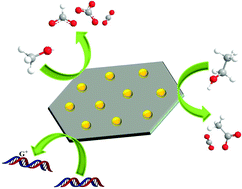Gold nanocatalysts supported on carbon for electrocatalytic oxidation of organic molecules including guanines in DNA
Abstract
Gold (Au) is chemically stable and resistant to oxidation. Although bulk Au is catalytically inert, nanostructured Au exhibits unique size-dependent catalytic activity. When Au nanocatalysts are supported on conductive carbon (denoted as Au@C), Au@C becomes promising for a wide range of electrochemical reactions such as electrooxidation of alcohols and electroreduction of carbon dioxide. In this mini-review, we summarize Au@C nanocatalysts with specific attention on the most recent achievements including the findings in our own laboratories, and show that Au nanoclusters (AuNCs, <2 nm) on nitrided carbon are excellent electrocatalysts for the oxidation of organic molecules including guanines in DNA. The state-of-the-art synthesis and characterization of these nanomaterials are also documented. Synergistic interactions among Au-containing multicomponents on carbon supports and their applications in electrocatalysis are discussed as well. Finally, challenges and future outlook for these emerging and promising nanomaterials are envisaged.

- This article is part of the themed collections: 2018 Frontier and Perspective articles and Molecular metal-containing soft materials


 Please wait while we load your content...
Please wait while we load your content...